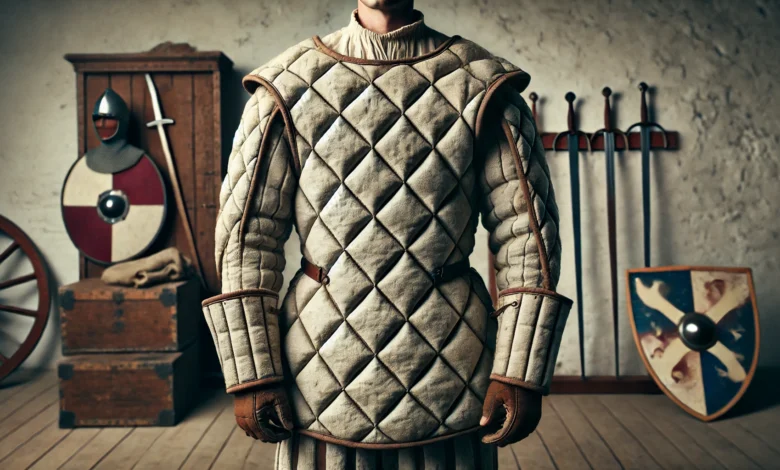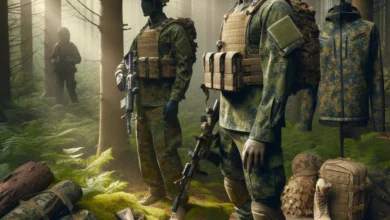Gambeson: The Versatile Armor of Medieval Warriors

Introduction
Wearers use a gambeson, a quilted padded protective garment, either alone or under mail or plate armor. Made from linen or wool, this medieval garment offers significant protection by reducing the impact pressure on the wearer’s body. Many military leaders of medieval Europe used gambeson because of their efficiency, low cost, and ability to optimize the fighting scenarios.
Now let’s consider such clothing that people can both fight and feel comfortable while wearing while being in a war. The gambeson transformed warfare, providing vital defense to knights and soldiers without restricting movement.
Common soldiers and knights wore gambesons between the 12th and 16th centuries because they were indispensable. The padding materials helped armored warriors avoid swords, arrows, and blunt force, making gambesons invaluable in battles.
The History of the Gambeson
People have worn gambesons for centuries, with different civilizations using padded armor even in prehistoric times. In medieval Europe the gambeson started appearing in the 12th century as a response to the flaws of the chainmail. Originally they were used as an undergarment with chain mail to provide soft tissue protection, but grew to be an armor independent protection. This piece of clothing became widespread and proved to be effective against attacks; therefore, its development came hand in hand with other pieces of medieval armor. With changes in the nature of the warfare, the gambeson also underwent certain changes according to the specific threats and tools of the trade of the time. This flexibility was the reason for its existence and growth throughout Europe and reaching to later centuries.
Construction and Materials of Gambeson
Crafters fashioned the gambeson from layers of fabric, typically stitching linen and wool in a quilt-like pattern to achieve stiffness and elasticity. Diamond or rectangular stitching used for distribution was getting blows. Craftsmen filled it with scrap cloth, horsehair, or straw to add bulk and elasticity to the core. This construction reversed impacts, important in Medieval combat, and with its lightness and breathability it was optimal for lengthy fights, which received approval of soldiers.
Gambesons in Battle: Protection and Versatility
On the battlefield, the gambeson’s multiple fabric layers protected against cuts, bruises, and arrows. It was also effective in assy nimbleness as it helped to absorb shock which made it preferable for foot soldiers. Knights and mounted warriors also used gambesons under their armor to provide additional protection and to provide cushion against the metals that made up their armor. This versatility ensured that the gambeson was a popular item in medieval warfare since it offered protection while at the same time did not inhibit the movement of the wearer. Thus, its aptness for various battle conditions predetermined its usage as an inherent attribute of any soldier’s equipment. As the armor technology wore on though, the gambeson was still useful to many a warrior.
Fashion and Function: The Gambeson’s Dual Role
The gambeson served as armor and contributed to medieval fashion, asserting one’s social status. It gradually transformed into a civil clothing at the end of the middle Ages; it was then used by the folk who wanted to look similar to knights. With its slim cut and stylishly placed ornamentation of embroidering and buttons, it was popular among the nobility. Thus, the rational and ornamental components incorporated into the construction of the gambeson enabled it first and foremost to serve pragmatic wear and tear purposes, with people wearing it both in the military and in their everyday civilian lives. The role of the garment proves its significance in the medieval society and culture by defining the trends amongst Europeans.
Types of Gambesons: From Basic to Advanced
Warriors used different types of gambesons based on their specialization. In the beginning the gambesons were more like a protection wear with little or no padding. Over time, the gambeson also advanced and the military versions were known to have dense padding to help out in the defense. The jack of plates which is a version that has metal plates sown into the fabric, was suited for countering attacks that involved piercing. Sub-styles such as the arming doublet were made for wearing under plate armor, thus creating the ideal fit and functionality. These differences highlight the gambeson’s construction and its adaptability to evolving warfare requirements over time.
Gambeson’s Role in Medieval Warfare
The gambeson was significant in warfare during the medieval age since it provided protection to the soldier alongside being economical. Due to the flexibility of the material used, the shield could move more freely than the metal form that could be used by infantry as well as archers. Due to these features, the gambeson would be an installment in both the offence and the defense plans of the warriors. subsequently the function of the gambeson changed as the weapons and fighting technologies developed, it was able to remain a significant part of the warfare. Due to its functionality in the hands of individuals of different ranks and positions in medieval armies, the throwing axe is a historic weapon most relevant in battles. This indicates how gambeson-inspired protective wear strongly correlates with modern protective gear and combat formations in contemporary warfare.
The Decline of the Gambeson
After introducing firearms in the sixteenth century, people phased out the gambeson from warfare, developing new armor materials and designs to protect against gunfire. Recognizing the need for increased protection, people developed clothing to prevent bullets and projectiles from piercing through. However, with this decline the mind-set of the gambeson began to shape the development of the today’s production body wears and protective apparels. The principles of the conception such as protection in layers and shock absorption are still seen in present protective equipment. Thus, the role of the gambeson in history is impossible to ignore as with it are modern means of armor protection originated. Its reduces signaled a monumental change in the overall history of personal protection in warfare.
Modern Relevance and Revival of the Gambeson
Today, this garment is popular among historical movie enthusiasts, staged battle participants, and LARP fans interested in medieval revival. Due to historical aspects as well as functionality, the armor is in demand when recreating medieval battles and occurrence. Also, the device of the gambeson can be classified as the basis for the modern fashion and costume design as demonstrated by the example of the device as a genderless and multifunctional piece of clothing. It is reviving in line with the subject’s increasing popularity as part of the Western medieval renaissance, history and the craft tradition that bridges the medieval and the modern world. This boosts the gambeson’s future use, emphasizing its traditional design for reenactments and its influence on modern fashion trends.
FAQ’s
What materials did craftsmen use to make gambesons?
Craftsmen typically made gambesons from linen or wool, stuffing them with cloth or horsehair.
How did the gambeson protect against arrows?
The padding in gambesons absorbed and dispersed the impact of arrows, reducing penetration and injury.
Did only knights use gambesons?
No, both knights and infantry soldiers used gambesons for affordable and effective protection.
Did gambesons have different styles?
Yes, styles varied from simple padded garments to advanced versions with metal plates for extra protection.
Why did the use of gambesons decline?
The rise of firearms required more advanced protective gear, leading to the decline of gambesons in military use.
Conclusion
Still, the gambeson remains to be an interesting piece of equipment, embodying the versatility of the medieval armor designs. That is why the helmet was not only necessary on the battle field to protect from slashing sword attacks and such but also to give an aesthetic and warm appeal to the wearer. Thus, studying the history of medieval wear, the significance of the gambeson does not change and remains the key to experiencing the craftsmanship of the medieval period and applying them today. Either in the historical enactments or the fashion revivals, the gambeson stands tall as the material that still holds its ground and diversification. Therefore, their influence on the concept of medieval, and modern armor, makes it an important piece of clothing for protection.




